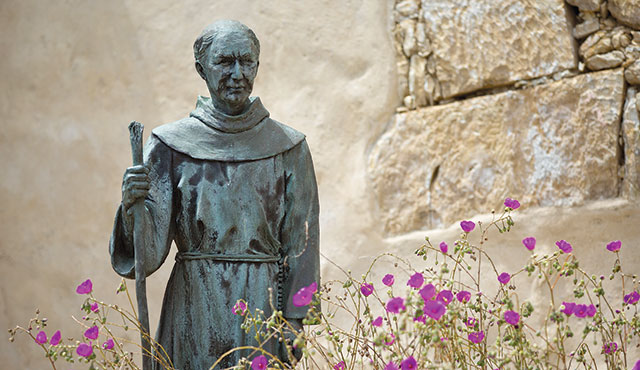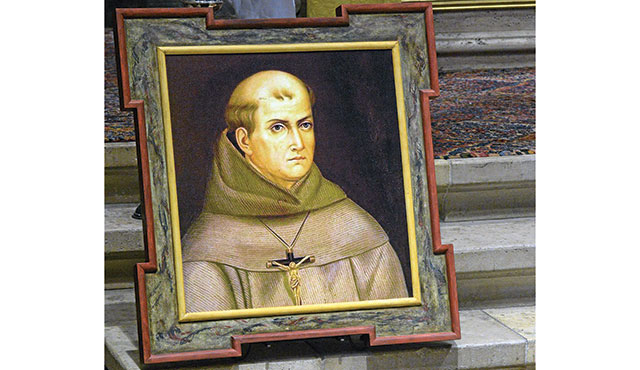Catholic saints forever serve as examples of faith. Their lives were rooted in Christ: all that He taught and all that He ultimately sacrificed for the world. As such, history has shown that the saints did the same.
The relics of these saints and martyrs serve as tangible connections to them. Millions throughout the world revere what they owned and touched. But the actual body parts, known as first-class relics, are held in greatest esteem.
Thanks to a generous parishioner, the Diocese now holds a first-class relic of the man who, more than anyone, was instrumental in establishing Catholicism in California: St. Junipero Serra. The origins of the Diocese and the foundation of the Catholic way in Orange County are a result of his extraordinary work. St. Serra founded nine of the 21 Catholic missions in what was known as Alta California. One of these, Mission San Juan Capistrano, is home to the Serra Chapel, built in 1783.
“It’s the only surviving chapel where St. Serra celebrated mass,” says Lesa Truxaw, director of the Diocese’s Office for Worship. “The Mission is obviously a significant place in local Catholic history.”
On Sept. 23, 2015, Fr. Serra became St. Serra when Pope Francis canonized him during his first visit to the U.S. The “Apostle of California” became the first to be canonized in this country.
The canonization process began when Pope John Paul II declared him venerable in 1985. The Pope beatified him three years later. However, one year before St. Serra’s beatification, his remains were exhumed from his place of burial, beneath the sanctuary of Mission Carmel, to be doubly sure that the site was indeed accurate. (He had been exhumed in 1943 as well.)
Leading the group that lobbied for St. Serra’s beatification was Franciscan Friar Fr. Noel Francis Moholy, who devoted four decades to eventually seeing him canonized. After the 1987 exhumation, Fr. Moholy left for the Vatican with its results, as well as several relics, on Serra’s behalf.
“My father was part of the group that was led by Father Moholy,” says Orange resident and St. Norbert parishioner David Moran, who donated the relic – actually two bone fragments – to the Diocese. “Father Moholy was really passionate about getting St. Serra beatified and worked hard to get him canonized. It’s too bad that he didn’t live to see that happen.”
Moran’s father became a fully committed Catholic during an exceedingly stressful ordeal, an ordeal he wasn’t sure he’d even survive.
“Dad was captured by the Germans during World War II,” Moran says. “While he was in the prison camp, he made a promise to God that if he got out alive, he’d say the rosary every day and attend church as often as he could. He kept his promise, and after he retired, he went to church seven days a week.
“And,” Moran adds, “he developed a fondness for relics.”
Moran’s father first obtained the St. Serra’s bone fragments in 1967, when his son was 8 or 9. The son was bequeathed the relic after his father’s passing, in 2016. (He also holds a copy of the Latin document that announces St. Serra’s beatification.)
Moran chose to donate the relic to the Diocese, because “I really want to share it with others. It was an honor to have it, but I don’t think it was right for one person to hang on to something as important as this. … I was going to donate the relic to Servite High, where I went, but I decided to give it to the Diocese instead. That way it can be seen by more people.”
The revamped Christ Cathedral’s 14,000-pound stone altar will soon be home to St. Serra’s relic, along with the relics of others.
“The relics will be placed in the altar during Christ Cathedral’s dedication Mass, just before the altar is anointed,” Truxaw says. (The Mass will be an important element of the Cathedral’s dedication, to take place on July 17.) “Each of the relics will have its own ‘mini-case.’ They’ll all be placed in one cedar box that will be installed in the reliquary attached to the altar.
“While many churches have relics,” Truxaw adds, “what’s significant about the St. Serra relic is its historical nature, and the fact that we have the relics of martyrs. That’s unusual.”
Before being permanently placed in Christ Cathedral’s altar, the relics will go on a local pilgrimage to all of the Diocese’s parishes.
To acknowledge St. Serra’s influence, particularly in Orange County, Bishop Kevin Vann has made St. Serra’s July 1 memorial (Serra’s birthday) “obligatory.”
“Not all memorials are obligatory,” Truxaw says. “Bishop Vann decided to do this because of the importance of St. Serra in local Catholic history.”
Truxaw adds a critical reminder about these relics – and all relics: “We’re venerating them in high esteem, but we’re not worshipping them. These relics don’t hold the same level as the Eucharist.”
Nevertheless, they’re very, very important.


